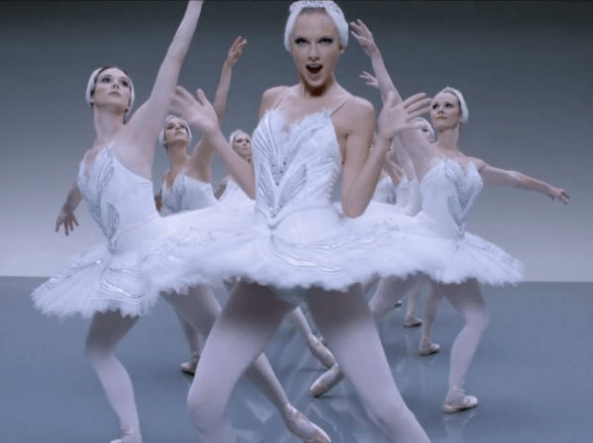
www.clydefitchreport.com
In her massive hit video, "Shake It Off," Taylor Swift bops cheerfully amidst breakdancers, ballerinas, twerkers, cheerleaders and musicians. The background performers break, ballet, booty bounce or cheer, while Swift boogies with vim unmarred by her utter lack of virtuosity. She looks confused as she tries to imitate break moves; she gazes with a mildly scandalized air at the twitching behinds of the twerkers; she gets pom-poms shoved in her face by the cheerleaders. The final image of the video is a tutu-cald Swift sinking gracefully into a pose, slipping and landing—thunk— lightly on her butt.
While the lyrics of the song are about shaking off critics, the visuals and subtext suggest that Swift is actually shaking off, not haters, but the very notion of competence and its inherent worth.
Swift here is following in the grungy footsteps of generations of punk performers who have been proud of their inability to play their guitars; it was about the message, about taking down the Man, not flexing one's nimble fingers. It's true that Swift is not remotely the Ramones; while the imagery may show Swift failing at a wide swathe of skills, the music itself never misses one pop-delicious beat. Still, the pretense of klutziness functions in much the same way in her music as it does with the Sex Pistols. It's meant to make her real, unslick, authentic.
For Swift, that authenticity seems to be a way specifically to escape, and repurpose, gender stereotypes.
Theorist Julia Serano writes in her 2007 book Whipping Girl that femininity is considered "artificial, contrived, and frivolous," even by (and sometimes especially by) many feminists. Swift—whose audience tilts young and female, and who often uses girly imagery (like the stuffed animals in "We Are Never Ever Getting Back Together")—has felt the sting of these stereotypes. "I've got nothing in my brain," she declares at the beginning of "Shake It Off," "that's what people say!"
As a femme woman and performer, Swift is often seen as an artificial, overly polished, vacuous product—a prefab soulless doll. "Shake It Off" attempts to free her of that image by presenting the singer as happily, unselfconsciously imperfect. It's a carefully calculated, artificial demonstration that Swift is not artificial. Inside the choreographed machine of ballerinas, twerkers and cheerleaders, Swift (and her fans) are figured as goofy, fallible and unapologetically "real."
Swift V. Beyoncé
To some degree, Beyoncé's recent video "7/11" is coming from a similar paradigm. Shot in a hotel room, it opens with Beyoncé doing a silly dance on her balcony and moves to her and her friends/background dancers drinking, rolling dice and goofing about, culminating in the opening of Christmas presents. Compared to Beyoncé's typical ultra-high glam presentation, her outfits—including quirky glasses, T-shirts and, yes, even sweaters—are all low-key and comfortable. The video seems designed to show you the "real" Beyoncé, palling around with friends, without the filter of stylists or handlers.
But while "7/11" signals lo-fi authenticity, that authenticity is never linked to incompetence or ineptitude like it is in "Shake It Off." Beyoncé is silly, but her silliness, like everything else she does, is flawless. In the privacy of her hotel bathroom, Beyoncé and her pals create perfect human pyramids swaying in immaculately dirty rhythm. For Taylor Swift, the joke is that she can't twerk like her background dancers; for Beyoncé the joke is that, even while playing around, she can.
Beyoncé, like Swift, is often accused of being prefabricated, her career constructed by someone (anyone!) else but her. But black women aren't just stereotyped as artificial. Rather—as Janell Hobson discusses in her 2005 book Venus in the Dark—black women are often constructed as "oversexed, primitive, savage and beastly," in contrast to "civilized" white women.
In her book Staging the Blues, Paige McGinley argues that female black performers have traditionally embraced inauthenticity as a way to undermine these vicious stereotypes that perpetuate the notion of black authentic "primitiveness." McGinley points to singers like Ma Rainey, who would appear on stage in elaborate costume after elaborate costume, pantomiming personas from Mammy to a regal queen in a single show. "7/11" can, then, be seen as a negotiation between different stereotypes. Beyoncé attempts to illustrate (like Taylor Swift) that she is "real," idiosyncratic and not beholden to a script, while at the same time retaining an aura of consummate professionalism, demonstrating that (like Rainey or Bessie Smith) she is a conscious performer, not just some sort of natural, "primitive" attraction.
Both Swift's video and Beyoncé's are also integrated; black and white performers shimmy, twirl and twerk together. Beyoncé leads a black and white group of friends from balcony to bathroom and back again; they are presented as all sisters together (though Beyoncé is definitely the sister who is capable of transcending race far better than her companions).
Swift's video is less seamless. With the break-dancers and twerking, Swift's naïve posturing could be read as a kind of parody of black style (and, in fact, it has been criticized as such). When she crawls through the legs of the rump-shaking, mostly black twerkers, her expression of amused shock could be read as her, once again, distancing herself from their competence, and presenting herself as authentic, unabashedly abashed. But given the association of black women with "dangerous sexuality," you could also argue that Swift is separating herself not from the women's skill, but from their forbidden, bad girl, sexualized primitiveness. Swift is real, but not, she assures you, as dangerously real as all that.
Swift almost certainly did not put together this video with the intention of presenting herself as a good white girl in contrast to those other, less good, less white women. The fact that it can be read this way is a result, no doubt, of the same amateur thoughtlessness that the video celebrates. For Swift, being able to make mistakes and look klutzy is an escape from the dreary white female pedestal of perfection. But that escape, in this case, involves in part reinscribing stereotypical images of black women.
Swift can afford to celebrate carelessness. Beyoncé, though, knows that even her casualness has to be perfect.






